Citizen Excellence in Community Involvement Award
The Citizen Excellence in Community Involvement Award is a national award given by the Environmental Protection Agency to an individual or a community group that has worked with an EPA Superfund team. This annual award recognizes outstanding achievements in environmental protection and community involvement leadership during the site cleanup process. EPA's regional offices nominate a citizen or community group that has demonstrated:
- Constructive participation in the community involvement process, identification of community concerns, compassion, dedication and interaction with EPA to find grounds for site cleanup results; and
- Leadership skills, a risk taker, results-driven, creative and/or innovative skills in devising and implementing ways to accomplish the community’s mission of a safer, cleaner environment.
A diverse panel of EPA Headquarters' staff review the nominations and select the most outstanding individual or group for the award.
Award Winners
- 2023: Holli Sandborn
- 2022: Sanders Beach Neighborhood Association, Inc.
- 2021: Eastwick Lower Darby Creek Area Community Advisory Group
- 2020: Sandy Wynn-Stelt
- 2019: Rachael Thompson
- 2018: Andrea Amico
- 2016: BoRit Community Advisory Group
- 2015: Passaic River Community Advisory Group
- 2014: Memphis Town Community Advisory Group
- 2013: Amy Garcia, Pueblo of Laguna
- 2012: Chemical Commodities, Inc., Concerned Citizens Group
- 2011: Lenny Siegel
- 2010: Woolfolk Alliance Group
- 2009: Palos Verdes Shelf Fish Contamination Education Collaborative Community Outreach Team
- 2008: Carol Johnston
- 2007: Savannah River Site Citizens Advisory Board
- 2006: Oak Ridge Site Specific Advisory Board Stewardship Committee
- 2005: Sue Walker
- 2004: Colorado Citizens Against ToxicWaste (CCAT) of Canon City, Colorado
- 2003: Clintel Betts
- 2002: Harold Mitchell
- 2001: Laurie Nehring
- 2000: Tri-Valley Communities Against a Radioactive Environment (Tri-Valley CARES)
2023 Award Winner: Holli Sanborn
EPA awarded Holli Sanborn with the 2023 Citizen Excellence in Community Involvement Award for her leadership as a community member and for effectively engaging with her fellow residents and the Globe Union Superfund Removal Site team to facilitate an effective and innovative response action to neighborhood contamination.
The Globe Union Superfund Removal Site in Garland, Texas includes elevated lead and arsenic levels resulting from historical industrial operations within the community. Contamination was identified along a local creek and neighboring an elementary school and residential neighborhood.
Holli was instrumental in connecting EPA with her community by meeting with EPA on a weekly basis for months until COVID restrictions were lifted, and field operations were allowed to proceed. She served as a liaison between EPA, the city of Garland, and the community to help distribute information and answer questions from local officials and community members about the Superfund site work.
Holli’s leadership and dedication amplified the voices of her community and helped them to understand and participate in the cleanup process. Despite COVID restrictions, she was able to share critical EPA outreach information through her neighborhood association and through various social media platforms, as she worked with all parties to identify ways the EPA site team could work effectively with the community.
Holli allowed non-contaminated mulch, which was generated from trees that were removed to gain access to the local creek during the cleanup process, to be used as replacement for lead-contaminated material on her own residential property. This innovative solution resulted in significant cost savings for the cleanup project.
Holli’s professionalism and dedication to fostering effective community involvement at the Globe Union Superfund Removal site resulted in conflict prevention and resolution support that truly helped the Agency moved forward with the removal action during unprecedented challenges resulting from the COVID pandemic.
2022 Award Winner: Sanders Beach Neighborhood Association, Inc.
EPA awarded the 2022 Citizen Excellence in Community Involvement Award to the Sanders Beach Neighborhood Association, Inc. for exemplary collaboration by the Sanders Beach community with EPA in advancing the cleanup of the American Creosote Works Pensacola Superfund site in Pensacola, Florida.
The Sanders Beach Neighborhood Association has worked with EPA as a key partner in the cleanup process since the site was listed on the National Priorities List in 1983, taking advantage of EPA’s full suite of community involvement resources to get involved and stay informed.
SBNA advocates for the community and fosters an inclusive environment where everyone has a voice at the table and a stake in the decision-making process. SBNA also serves as a liaison between EPA and the community by helping distribute information and answer questions from local officials and residents about the cleanup in their community.
With help from the College Underserved Community Partnership Program, SBNA connected with the University of West Florida to draft potential reuse plans for the site, which envisions transforming the former industrial site into a community park after the cleanup is complete. Their collaboration with UWF included input from students and professors to help design the potential new park.
2021 Award Winner: Eastwick Lower Darby Creek Area Community Advisory Group
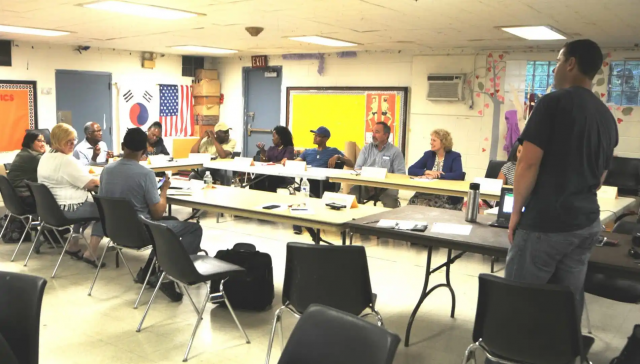
Photo courtesy of Southwest CDC
EPA awarded the 2021 Citizen Excellence in Community Involvement Award to the Eastwick Lower Darby Creek Area (ELDCA) Community Advisory Group (CAG) for their remarkable dedication to their community and commitment to successful collaboration with EPA.
Since its inception just six years ago, the CAG has unified the community’s voice and restored relations with EPA, enabling the Superfund cleanup process to continue with greater community support.
The Eastwick Lower Darby Creek community has faced long-standing environmental justice issues due to a history of flooding, toxic dumping, and heavy industry in the area spurred by the largest-ever U.S. urban renewal project.
Throughout the 1950s and ’60s, the Redevelopment Authority of Philadelphia (RDA) displaced over 8,600 people from their homes, and in the process, dismantled one of Philadelphia’s only racially integrated communities at that time.
Community leaders demonstrated strength, persistence, and resilience in overcoming these tremendous obstacles to unite residents in tackling the legacy contamination in their community.
The CAG consistently holds monthly meetings and has maintained open and honest communication with EPA, resulting in a mutually positive and productive relationship. Together, the site team and the CAG have become adept at identifying issues, community needs and quickly disseminating important site information.
The CAG has effectively leveraged EPA resources through EPA’s Technical Assistance Grant (TAG) program, enlisting the help of an environmental consulting firm to facilitate the CAG’s understanding of the site-specific cleanup process. Experts from the University of Pennsylvania also serve as CAG members to provide health and geological information.
The CAG’s commitment was evident while dealing with personal property damage due to flooding from Tropical Storm Isaias. They devoted the time to organize and participate in virtual meetings on short notice with EPA staff and local elected officials, and effectively utilized EPA resources to educate and meet the ever-changing needs of the Eastwick community.
2020 Award Winner: Sandy Wynn-Stelt
EPA awarded Sandy Wynn-Stelt with the Citizen Excellence in Community Involvement Award for her enduring commitment to community advocacy and engagement at the Wolverine World Wide Tannery Superfund site in Kent County, Michigan.
Sandy was compelled to act after learning her home sits directly across from the tannery’s contaminated waste dump known as the House Street Disposal Area. This former disposal site most notably polluted groundwater with per- and polyfluoroalkyl substances, or PFAS, which are man-made chemicals that don’t break down in the environment. PFAS can accumulate in the body and potentially lead to adverse health effects. Sandy’s drinking well water tested among the highest in the nation for PFAS contamination.
Sandy began hosting weekly neighborhood meetings and forging relationships with site staff from the Agency and the Michigan Department of Environment, Great Lakes, and Energy (EGLE) – serving as a liaison between the agencies and affected residents. She informed community members on the Superfund site work and assisted EPA staff by suggesting meeting locations and formats. Sandy played a key role in forming the local Community Advisory Group (CAG) and was subsequently chosen by members for one of three leadership positions. She ensured the group represented the diversity of community interests and that those diverse interests were heard and accounted for in the cleanup decision-making process. She even developed comment cards for public meetings that allowed residents to submit unaddressed questions to be answered by site staff after meetings ended.
Her measured leadership proved highly effective in diffusing an emotionally charged public meeting regarding an unpopular proposal to dispose of contaminated waste in the area. Through respectful dialogue, she channeled community tension into productive conversations, leaving both sides feeling heard and understood.
Her invaluable contributions as a community advocate extend beyond Michigan to Washington D.C., where she testified in front of Congress on the profound impact of the Superfund site on residents and their livelihoods. Sandy exemplifies citizen excellence through her tireless dedication to residents and the community as she continues her leadership position in the advisory group.

2019 Award Winner: Rachael Thompson
EPA awarded Rachael Thompson with the Citizen Excellence in Community Involvement Award for her outstanding leadership in collaborative community engagement at multiple Superfund sites in the Brunswick, Georgia community. Ms. Thompson was selected as the Executive Director of the Glynn Environmental Coalition in 2018 and immediately began requesting meetings with EPA in hopes to rebuild the 20-year relationship between the community and the Agency.
Ms. Thompson’s dedication, creativity and innovative skills in devising and implementing ways to educate the community and build collaborative relationships, changed the dynamic between the Agency and the Brunswick community. Ms. Thompson utilized EPA’s Technical Assistance Grant to hire a new technical advisor to independently interpret EPA’s technical documents so the community would able to provide informed feedback on the remedial activities at the local Superfund sites. This is a significant part of the decision making required for a cleanup of Superfund sites. She helped organized and cohost, along with EPA, a Superfund 101 workshop held one Saturday morning in her community. The purpose of the workshop was to meet the needs and requests of the community and help increase community participation within the Superfund process. She routinely goes out of her way to work directly with the Agency to not only answer questions from local officials, but to suggest multiple routes to constructive dialogue an engagement between the community and the Agency. Her tireless efforts to accomplish solutions are extremely admirable.
2018 Award Winner: Andrea Amico

EPA awarded Andrea Amico with the Citizen’s Excellence in Community Involvement Award for her advocacy around the former Pease Air Force Base Superfund site in Portsmouth/Newington, New Hampshire. Andrea is a resident of Portsmouth, where Pease is located. She is a wife and mother of two small children who attended daycare full-time at Pease. When her entire family was directly impacted by water contamination (her husband was employed for a company on Pease), she wanted to learn more about the exposure they were facing.
In the last four years, Andrea has been a leader in the Pease community. She has worked effectively with EPA, the New Hampshire Department of Environmental Services, the Agency for Toxic Substances and Disease Registry, and elected officials to aggressively address the challenging issue of “emerging contaminants” at Pease. Historic firefighting and training activities by the Air Force resulted in contamination of public and private water supply wells by poly- and perfluoroalkyl substances (PFAS) at levels above EPA’s health advisory. Andrea’s leadership and commitment to working with the community and site team over the past four years has increased community participation not only at the Pease site, but at other Superfund and state-lead PFAS sites in New Hampshire’s seacoast area. In 2015, Andrea co-founded the Testing For Pease community group and its website and Facebook page with two other mothers from Pease daycares.
Andrea is an inspirational leader who serves as a model community advocate in forming relationships and collaborating with government and elected officials to voice her concerns and achieve the community’s goals. She serves as a highly visible liaison between many government agencies and the local community. As a genuine leader, she always credits other concerned parents, community members, and federal and state elected officials for their support and participation in investigations and cleanup at the former base. Andrea notes that there is much more work to do, many more people to reach, and much more to be learned about PFAS and emerging chemicals.
2016 Award Winner: BoRit Community Advisory Group

The BoRit Community Advisory Group (CAG) was recognized by the U.S. Environmental Protection Agency (EPA) as the winner of the 2016 Citizen Excellence in Community Involvement Award.
EPA recognized the BoRit Community Advisory Group (CAG) for its excellence in engaging community members regarding the BoRit Asbestos Superfund site in Ambler, Pennsylvania. Since 2007, the BoRit CAG’s bimonthly meetings have provided a forum for the community to have a dialogue with EPA. The meetings have also forged a partnership between the community and EPA to develop solutions for addressing the asbestos waste pile at the site.
The many accomplishments of the BoRit CAG include:
- Using EPA’s technical assistance programs to understand the removal and remediation process, which has informed the community’s participation in decision making;
- taking part in the University of Pennsylvania’s efforts to collect residents’ health and exposure histories to aid the university’s research into the effects of asbestos on human health; and
- pursuing information about emerging asbestos detection technologies and obtaining equipment from overseas universities to demonstrate locally.
The CAG’s efforts fostered a high level of community involvement throughout the process. The CAG continues to play an important role in ensuring that BoRit’s cleanup is community driven.
2015 Award Winner: The Passaic River Community Advisory Group

The CAG also effectively used a Superfund Technical Assistant Grant, the Technical Assistance Services for Communities program, and the EPA neutral facilitation program to access technical expertise that allowed them to examine critical aspects of the cleanup, and to effectively disseminate information to the community. Experts from these programs provided technical assistance that helped inform the CAG about dredging and sediment disposal technologies, which in turn allowed the group to submit timely, informed and effective comments.
EPA is confident the Passaic River CAG will continue to ensure the future cleanup of the Passaic River will connect people to the water and support the wide range of benefits that a healthy waterway can provide.
2014 Memphis Town Community Advisory Group
Kerr-McGee Chemical Corporation-Columbus Superfund site, Columbus, Mississippi
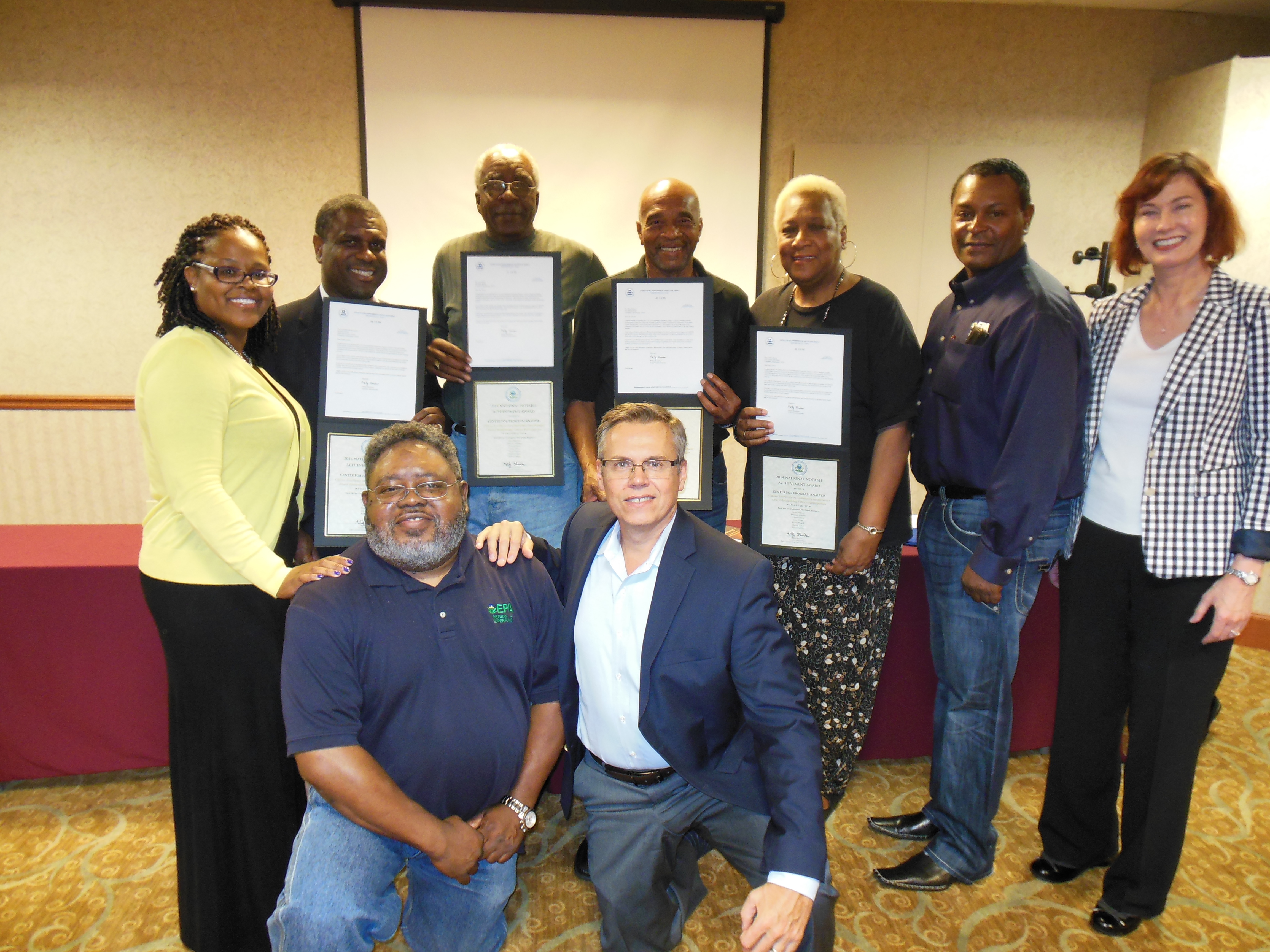
The Memphis Town CAG is being recognized for their commitment and dedication to the community of Columbus, MS where the Kerr-McGee Chemical Corporation-Columbus Superfund site is located. The Memphis Town CAG used their monthly meetings as a forum to identify community concerns, and they in turn partnered with EPA and the Mississippi Department of Environmental Quality (MDEQ) to identify acceptable solutions.
The CAG applied for and received a Technical Assistance Grant to obtain technical support for the Kerr-McGee site. The technical advisor assisted the local community in providing meaningful comments to EPA, MDEQ and the City of Columbus on site-related work plans and design documents. The CAG also assisted EPA and MDEQ by identifying the best options for sharing information with the local community.
The CAG was instrumental in creating a vision for the future for the site that includes a proposed solar energy facility at the site that ultimately could power a community center, new small businesses, new health centers, parks and gardens which would help promote a healthier and more sustainable community.
The EPA recognized the Memphis Town Community Advisory Group on July 22, 2014, at a CAG meeting held in Columbus, Mississippi.
2013 Award Winner: Amy Garcia, Pueblo of Laguna
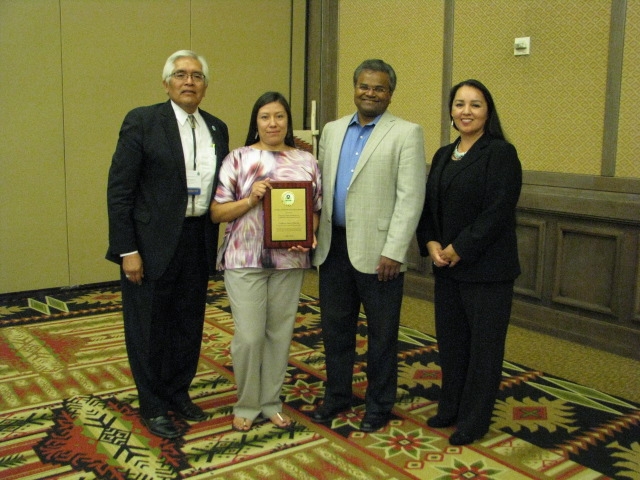
The EPA selected Ms. Garcia for her commitment and dedication to the community of Laguna, New Mexico where contaminated residential properties from uranium mines are located throughout the six villages within the Pueblo of Laguna, and for her efforts to ensure the community remained informed and engaged in EPA's decision-making processes.
Ms. Garcia's dedication to community engagement at the Pueblo of Laguna villages assisted EPA in obtaining access agreements to assess and remediate over 500 residential properties. Her assistance to EPA as a liaison to the Pueblo greatly improved the success and effectiveness of EPA's cleanup efforts by keeping Tribal members and homeowners informed every step of the way during the assessment and cleanup process. Her assistance also allowed EPA staff and its contractors to be well informed of Tribal customs and protocols. By using individual village meetings to ensure EPA and village members understood procedures, information was disseminated in a timely manner leading to the successful completion of the cleanup. Ms. Garcia's work ensured the Tribal members' interests in the future use of the land were taken into consideration during the assessment and remediation.
Assistant Administrator Mathy Stanislaus presented the award to Ms. Garcia at the Institute for Tribal Environmental Professionals' Tribal Lands and Environment Forum on August 20, 2013, in New Mexico.
2012 Award Winner : Chemical Commodities, Inc., Concerned Citizens Group
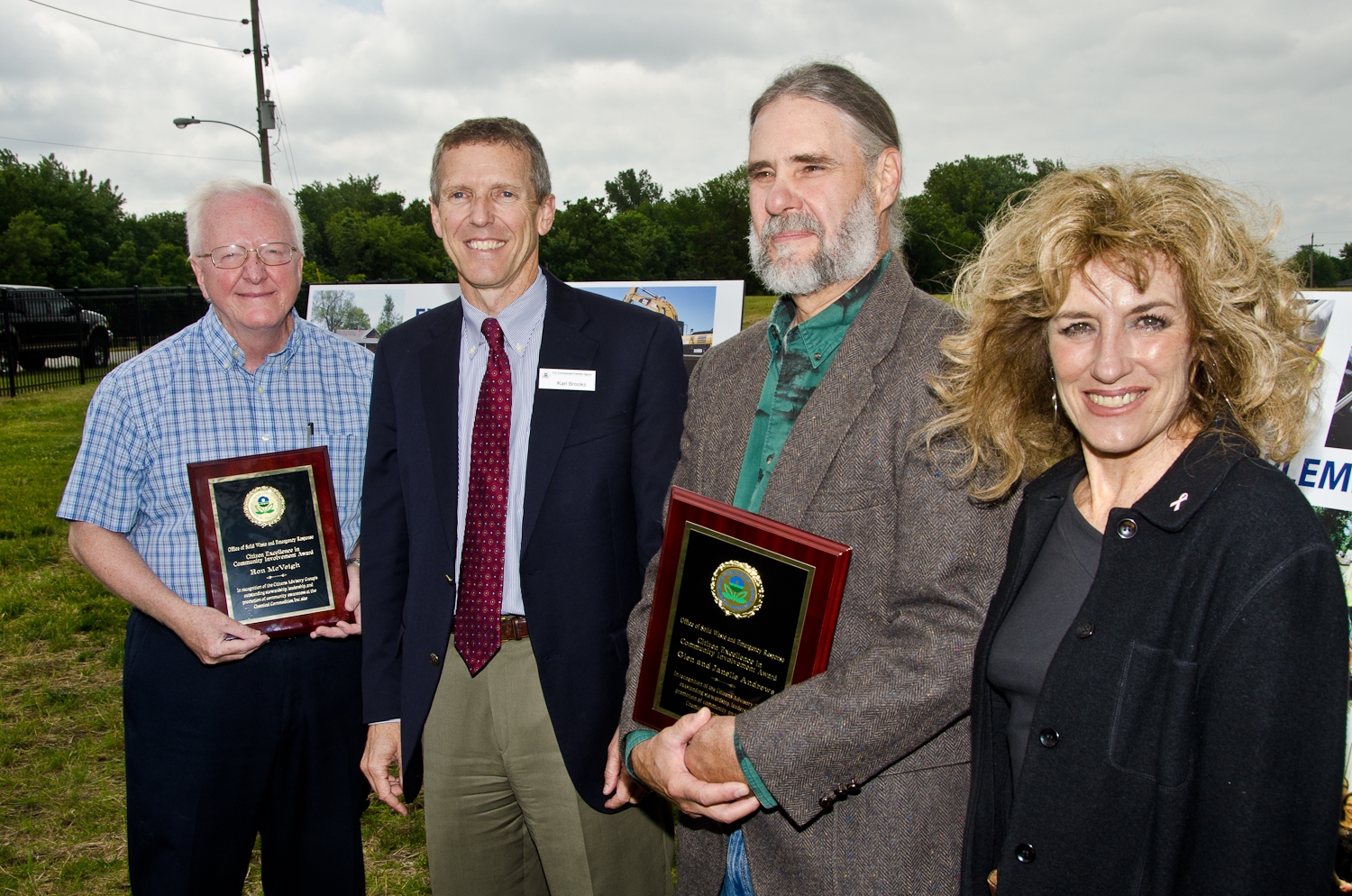
The 2012 Citizen Excellence in Community Involvement Award winners are Glen Andrews, Janell Andrews and Ron McVeigh. This award is presented annually to an individual or community group working with a Superfund team for outstanding achievements in the field of environmental protection.
Mr. and Mrs. Andrews and Mr. McVeigh are being recognized for their commitment and dedication to the community of Olathe, Kansas where the Chemical Commodities, Inc. (CCI) Superfund site is located. Mr. and Mrs. Andrews and Mr. McVeigh were Co-Chairs of the CCI Concerned Citizens Group where they served to ensure their community remained informed and engaged in EPA's decision-making processes.
Since 2001, Mr. and Mrs. Andrews and Mr. McVeigh kept the community informed about cleanup progress at the site, and ensured community concerns were expressed to EPA, the potentially responsible parties (PRPs), and the state. They helped change the community's attitude from one that had been reactive to one that was proactive and cooperative. In doing so, they worked with EPA to develop a plan to remove a dilapidated warehouse building on the site. The building was an eyesore to the community and a symbol of bad memories of past events at the site. As a result of this collaboration, EPA was able to demolish the building and remove contaminated soils which had also been stockpiled at the site.
Mr. and Mrs. Andrews and Mr. McVeigh established a strong working relationship with the EPA and Kansas Department of Health and Environment, and they worked to ensure all remedial options were reviewed carefully and that all potential technologies were evaluated by the PRPs. The Co-Chairs worked with the PRPs to ensure the community's interests were addressed about future land use and the community's desire for a positive outcome for the site. Currently, the PRPs are working with EPA and the community to develop a natural habitat for Monarch butterflies.
2011 Award Winner : Lenny Siegel
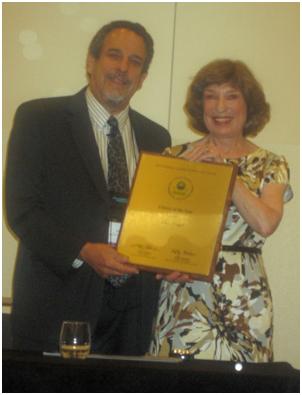
Lenny Siegel of Mountain View, California, was recognized by the U.S. Environmental Protection Agency (EPA) as the winner of the 2011 Citizen Excellence in Community Involvement Award on Tuesday, July 19, 2011. EPA gives this award annually to recognize an individual or a community group, who has worked with an EPA Superfund team, for outstanding achievements in the field of environmental protection and for demonstrating community involvement leadership during the site cleanup process.
The EPA selected Mr. Siegel based on his commitment and dedication to the Mountain View, California, community where the Naval Air Station (NAS) Moffett Field Superfund site and the Middlefield-Ellis-Whisman (MEW) Superfund Study Area are located. Mr. Siegel is an active member of the NAS Moffett Field Restoration Advisory Board, where he led the formation of a technical subcommittee to address specifically the community's preservation and cleanup concerns surrounding a huge structure to house dirigibles known as "Hangar One."
Mr. Siegel is one of the nation's leading experts on both military facility contamination and the vapor intrusion pathway. He has been Executive Director of the Center for Public Environmental Oversight (CPEO) for over 16 years. CPEO promotes and facilitates public participation in the oversight of environmental restoration activities at federal facilities, Superfund and Brownfield sites.
In presenting Mr. Siegel with his award, Elizabeth Southerland, Director of the Assessment and Remediation division in the EPA's Office of Superfund Remediation and Technology Innovation, commended him for his extraordinary commitment and dedication to environmental restoration efforts at the local community, regional and national levels. She also recognized his efforts to encourage active participation of all community members, his outstanding ability to simplify complicated technical and programmatic issues, and his consensus-based and interest-based approach to reach common ground and find workable solutions.
The EPA recognized Mr. Siegel at the Agency's 2011 National Community Involvement Training Conference, held in Arlington, VA, on July 19-21, 2011.
2010 Award Winner : Woolfolk Alliance Group
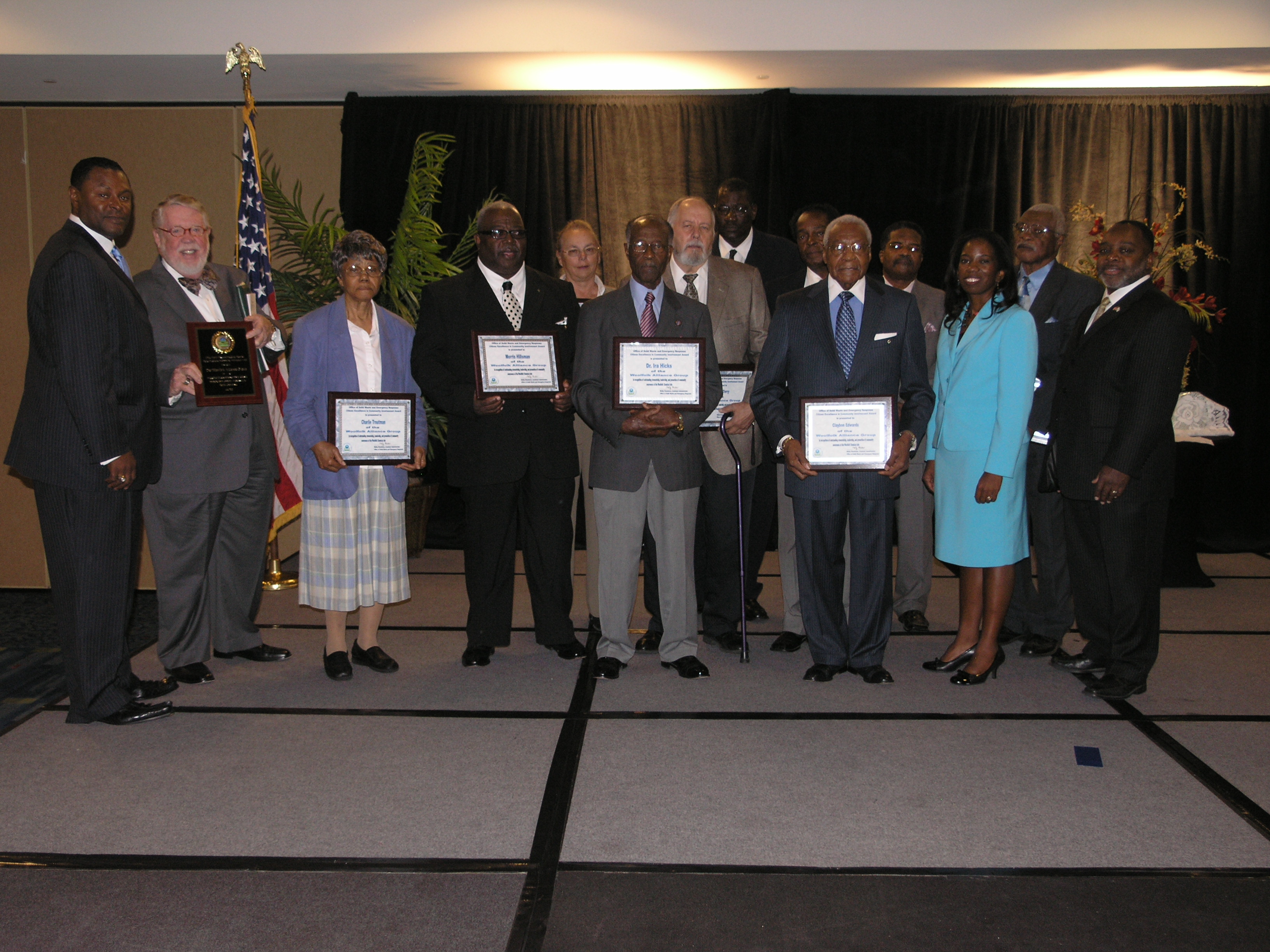
The Woolfolk Chemical Works Superfund site, located in Fort Valley, Georgia, occupies approximately 31 acres, including the former Woolfolk Chemical Works plant property and surrounding commercial areas. Since the 1920s, the Woolfolk facility had been used for the production, packaging, and storage of organic and inorganic insecticides, including arsenic, DDT, lindane, toxaphene, and other chlorinated compounds.
The Woolfolk Alliance Group has expressed the environmental concerns of the community to EPA, the State, the Agency for Toxic Substances and Disease Registry (ATSDR), and public health officials for more than ten years. The Woolfolk Alliance Group facilitates information exchange among the stakeholders while maintaining the local community’s desire to have a safer, cleaner environment and a “life after Superfund.” For the community, “life after Superfund” is measured by the City’s demonstrated ability to reuse the formerly contaminated and stigmatized land in a productive way.
Early on, the community was anxious about the initial redevelopment projects on and adjacent to the site. Construction of the new Thomas Public Library on the formerly contaminated property provided frequent opportunities to show how remediation and redevelopment can be combined to protect human health and the environment and improve the local quality of life. The new library and the renovation of the Troutman House, now a tourist information center and office space for local government agencies, have acted as catalysts to encourage homeowners to revitalize the surrounding neighborhoods. EPA commends the Woolfolk Alliance Group for its dedication to the cleanup and redevelopment of the Woolfolk Chemical Works site.
2009 Award Winner: Palos Verdes Shelf Fish Contamination Education Collaborative Community Outreach Team
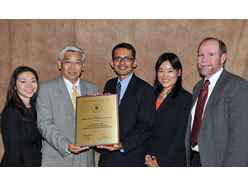
The Palos Verdes Shelf Superfund Site is an area of contaminated sediment on the continental shelf off the Palos Verdes Peninsula in Los Angeles, CA. The sediment is contaminated with DDT and PCBs from historical industrial releases. Fish, particularly bottom-feeders such as white croaker, contain levels of DDT and PCB that warrant fish advisories.
The PVS FCEC provides education on the dangers of consuming contaminated fish, as well as recommended eating and preparation guidelines to local communities, school groups, health clinics, and fish markets. The FCEC also developed educational materials that have been translated into nine languages to ensure all affected local communities are adequately informed of health issues related to contaminated fish consumption. In addition to extensive hands-on outreach, the FCEC also maintains a website, www.pvsfish.org, that contains educational resources on fish consumption recommendations and fish preparation tips.
The PVS FCEC Community Outreach Team, composed of both local organizations and community members, has used a plethora of tools to ensure all affected communities are reached. The variety and extent of the outreach activities conducted by the FCEC serve as a shining example for community groups and individuals across the country seeking to constructively participate in the cleanup of a hazardous waste site.
2008 Award Winner: Carol Johnston
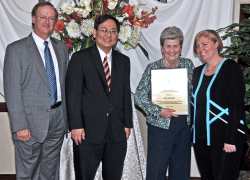
The 2008 Citizen Excellence in Community Involvement Award winner is Carol Johnston of Newark, New Jersey. The Citizen Excellence in Community Involvement Award was created to recognize an individual or a community group for making a contribution to a Superfund cleanup through their leadership, constructive participation, exceptional dedication, and creativity.
Ms. Johnston is a resident of the Ironbound Community in Newark, NJ. For nearly a decade, Ms. Johnston has worked closely with EPA officials and community residents to ensure the community's concerns are heard. She has been a tireless advocate on behalf of the poor and the disadvantaged within her community.
Through the development of the Ironbound Master Plan, the Ironbound Recreation and Open Space Plan, and the Gateway Park Plan, Ms. Johnston brought a variety of stakeholders into the development process over the course of almost ten years. Additionally, she annually helps to organize a bus tour for decision makers to impacted areas within downtown Newark so they can see first-hand the disproportionate impact of pollution on low-income and minority families.
Ms. Johnston's efforts in 2007 for the Ironbound Community included recommending a collaborative community involvement process for EPA to consider, arranging and conducting a personal tour for the EPA Region 2 Administrator to blighted areas, and acquiring the services of a volunteer technical advisor.
Ms. Johnston was presented the award on May 20, 2008, at the U.S. Environmental Protection Agency's 2008 National Notable Achievement Awards Ceremony in Arlington, VA.
Carol Johnston passed away on March 25, 2013, after a courageous fight with cancer.
2007 Award Winner: Savannah River Site Citizens Advisory Board
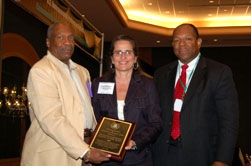
The Office of Superfund Remediation and Technology Innovation is pleased to announce the Savannah River Site Citizens Advisory Board (SRS CAB) as this year's winner of the Citizen Excellence in Community Involvement Award. This award recognizes an individual or a community group working with EPA to address hazardous waste issues. The Citizens Advisory Board is recognized for their dedication and commitment to the residents around the Savannah River Site in Aiken and Barnwell counties, South Carolina.
The SRS Citizens Advisory Board (CAB) is composed of a group of non-partisan individuals who strive to ensure that effective communication exists between SRS impacted communities, and to give stakeholders a key role in the decision-making processes of the U.S. Department of Energy (DOE), the Environmental Protection Agency –Region IV (EPA), and the South Carolina Department of Health and Environmental Control (SCDHEC). The CAB provides informed and timely recommendations to the DOE, EPA, SCDHEC and SRS management concerning issues such as environmental restoration, waste management and activities related to these functions at the Savannah River Site.
From the early 1950s to 1988, the Savannah River Site served as a production site for materials used in nuclear weapons. As a result of these production processes, chemical and radioactive wastes were treated, stored or disposed of at SRS, resulting in widespread soil and groundwater contamination. Since this time, more than 323 of 515 waste sites have been closed, using several ground-breaking remediation techniques to clean up the area. Over the past thirteen years, the SRS CAB, has succeeded in contributing over 250 recommendations, which have significantly enhanced risk reduction and cleanup success at the SRS. The SRS CAB also formed several working groups to subsidize the work of CAB Committees on long-term remediation issues. These working groups provided a means for community volunteers to participate in the decision-making process as key stakeholders, while contributing valuable knowledge and insight to complex issues.
In addition to numerous scheduled committee meetings and individual efforts, the SRS CAB advanced public education on a variety of topics related to the SRS by leading a multi-sponsored educational forum. Segments on transportation, treatment and final disposition of spent fuel were included in the forum, along with an introduction to spent fuel, a panel discussion, and an exhibit program. The SRS CAB's outreach techniques are furthered by the production of Board Beat, a semi-annual newsletter about SRS and CAB activities, which is provided to over 2000 interested stakeholders.
The EPA commends the Savannah River Site Citizens Advisory Board members for their hard work and dedication to ensuring community involvement in the remediation process at the Savannah River Site. The award was presented on June 21, 2007 at the EPA Community Involvement Training Conference in Jacksonville, FL. Donna L. Antonucci, CAB Co-Chair, accepted the award at the conference on behalf of the SRS CAB.
2006 Award Winner: Oak Ridge Site Specific Advisory Board Stewardship Committee
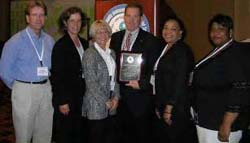
The Office of Superfund Remediation and Technology Innovation is pleased to announce the Oak Ridge Site Specific Advisory Board Stewardship Committee as this year's winner of the Citizen Excellence in Community Involvement Award. This award recognizes an individual or a community group working with EPA to address hazardous waste issues. The Stewardship Committee is recognized for their dedication and commitment to the residents around the Department of Energy Oak Ridge Reservation Site in Oak Ridge, TN.
The Oak Ridge Site Specific Advisory Board (ORSSAB) was established in 1995 to reflect the concerns of the communities impacted by cleanup of the Oak Ridge Reservation and to serve as a communication link between the public and the Department of Energy (DOE). The Board is comprised of twenty members and has included two to three high school students each year since 1999. Board members are appointed by DOE and serve on a voluntary basis, without compensation.
During fiscal year 2005, the Stewardship Committee completed two important achievements that strengthened the community's participation in the cleanup of the site; the Stewardship Education Resource Kit and the development of a process to facilitate tracking contaminated parcels of DOE land. The Stewardship Education Resource Kit provides local educators with the tools to engage students in developing a general awareness of environmental cleanup issues and long-term stewardship issues at the site. The Kit contains lesson plans, videos, a fictional case study on actual cleanup operations, an appendix of supporting materials, and a video CD on the background and use of the Kit.
During World War II, the Oak Ridge Reservation played a significant role in developing nuclear weapons. As a result of the nuclear weapons development, extensive radiological and chemical contamination occurred over several decades. Because of the extensive contamination and acreage involved, much of the radioactive waste will be managed on site and will remain a potential health and environmental hazard for thousands of years. To ensure that these contaminated parcels of land are tracked, the End Use Working Group was formed in 1997. The Group recommended that the information necessary for long-term care of perpetually contaminated areas reside in a system that would transcend DOE's presence at the site. The Group also recommended that a plat map be placed into the geographical information system (GIS) of the county property assessor as well as the city's GIS system. The text contamination notices and the plat locations are now available on-line at no cost via the Anderson County Register's document retrieval system and the City of Oak Ridge's GIS system.
The award was presented to the Oak Ridge Site Specific Advisory Board Stewardship Committee on June 29, 2006, at the EPA Community Involvement Conference and Training in Milwaukee, Wisconsin. Kerry Trammell, board chairperson, Heather Cothron, ORSSAB board member and Peter Osborne, ORSSAB Administrator accepted the award at the conference on behalf of the entire ORSSAB.
2005 Award Winner: Sue Walker
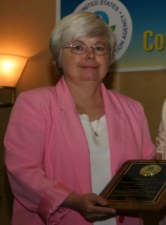
Sue Walker from Sandwich, Massachusetts was presented the Citizen Excellence in Community Involvement Award on July 14, 2005, at the EPA Community Involvement Conference and Training that was held in Buffalo, New York. This award was created to recognize an individual or a community group for making a contribution to a Superfund cleanup through their constructive participation and exceptional dedication, and their leadership skills and creativity.
Ms. Walker is involved in the cleanup of the Massachusetts Military Reservation (MMR) site on Cape Cod. One of the things that stands out about Ms. Walker is her exceptional dedication. She has been a key and visible community advocate for cleanup at the MMR site for 23 years. She has a reputation for never missing a meeting, and has attended literally hundreds of meetings.
Though she is well versed on the technical issues at the MMR site, she has chosen to stay focused on ensuring there is a strong community involvement process in place at the site that allows for constructive public participation in the site cleanup. Ms. Walker was an advocate for establishing the Public Information Team, a citizen advisory team which separates the community involvement component from the technical site issues. Ms. Walker wrote a document called "Community Involvement: Lessons Learned" that is based on her many years of experience.
Ms. Walker brings to the table her leadership, and ability to develop other team members as community leaders. She exemplifies citizen excellence in community involvement through her efforts to reach out to local non-profits and individuals in an effort to bring in new volunteers to the MMR citizen advisory teams.
She has worked closely with EPA and the state to develop one of the largest and most politically active community involvement programs at any Superfund site. EPA congratulates Ms. Walker on her many accomplishments at the MMR site.
2004 Award Winner: Colorado Citizens Against ToxicWaste (CCAT) of Canon City, Colorado
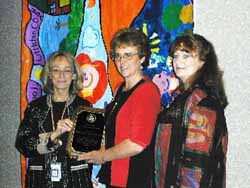
Bold. Dedicated. Inspirational. All of these words describe the efforts of Colorado Citizens Against ToxicWaste (CCAT) of Canon City, Colorado, the winner of the 2004 Citizen Excellence in Community Involvement Award. The Environmental Protection Agency (EPA) presented CCAT with this award at its annual Community Involvement Conference in Denver, Colorado on June 17.
CCAT serves as an inspirational example of what dedicated community members can achieve. In a relatively small time period, CCAT developed a multi-faceted community involvement process to implement its mission "to inform and educate the public regarding toxic and radioactive waste." To achieve its mission, CCAT holds regular public meetings to inform citizens about the Lincoln Park Study Area Superfund Site, frequently contributes material to local media outlets, and publishes educational flyers. CCAT also actively involved citizens in the political process by sponsoring candidate forums during election cycles, informing elected officials and regulatory authorities of pertinent developments in their community, and engaging citizens in constructive discourse.
Although CCAT's co-chairs and most of its board have full-time jobs, they spend numerous hours in the records centers of the state health department and EPA researching their position papers and educating themselves to enable them to better inform the public. The EPA awarded CCAT a $50,000 Technical Assistance Grant (TAG) to hire independent technical experts to examine existing data relevant to the site and remedy. CCAT has successfully used this grant to provide additional scrutiny of technical issues related to the site.
CCAT has been successful at informing the public on issues surrounding the Lincoln Park Study Area Superfund Site. For example, when a local uranium mill attempted to change its mission from processing to direct disposal of radioactive waste, CCAT alerted the public to the state health department's re-licensing process and requested that the state hold public meetings to hear citizens' concerns. As a direct result of CCAT's efforts, these concerns were codified in two Colorado State House Bills that ensure public participation in the state health department's licensing process for facilities that want to accept hazardous waste.
In addition, CCAT has assisted the EPA Site Team in developing innovative formats for government-sponsored public meetings. Through discussions with CCAT, the EPA has developed an "All Topics Considered" Public Meeting in Canon City, which features a freestyle format where citizens can present any questions or concerns to EPA officials. The site's EPA Community Involvement Coordinator is also collaborating with CCAT to establish videoconferences to focus on technical problems at the site. By using videoconferences, EPA's experts can directly converse with the community's technical-minded citizens while saving time and money for the community or EPA.
The EPA commends CCAT members for their efforts to involve the community in environmental policy discussions that directly affect local residents. Their actions will have a lasting impact on their community and the State of Colorado.
2003 Award Winner: Clintel Betts
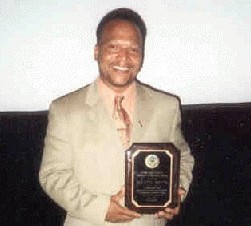
Clintel Betts of Kansas City, KS, is the recipient of the 2003 Citizen Excellence in Community Involvement Award. Mr. Betts received his award at the Environmental Protection Agency's (EPA) Community Involvement Conference in Philadelphia, PA, on July 24, 2003. The Citizen Excellence in Community Involvement Award is an award given by the Environmental Protection Agency (EPA) to recognize an individual or a community group working with the Agency to address hazardous waste issues. The EPA commends Mr. Betts for his commitment and dedication to the residents of his community around the John Garland Park site in Kansas City, KS. John Garland Park is located in the Northeast area of Kansas City, and is currently a brownfields site. The park was originally a landfill that the city converted to a park in 1982. Since the park's opening, degradation of material in the landfill resulted in settling. Eventually, because of health and safety concerns voiced by the community, the city closed the park. The Oak Grove Community Group was formed because of the community's health and safety concerns.
Mr. Betts has been the chairman of the Oak Grove Community Group for the past three years. He initially accepted this responsibility with apprehension, but was inspired by his mother to continue on with the effort. His mother believed he was the right person to be the chairman, and to assume a leadership role in the community. He also accepted the leadership role because he wanted to raise his children in a safe and clean environment. He saw this as an opportunity to learn more about environmental issues in his neighborhood, and to assist the community in getting assistance with the landfill. Mr. Betts has demonstrated true leadership by investigating the history of the site, and providing what he learned to the community through a series of neighborhood meetings.
Under the direction of Mr. Betts, the Oak Grove Community established a partnership with Associated Youth Services, a local non-profit organization, and the Technical Outreach Services for Communities program at Kansas State University. Through these partnerships a visioning workshop was held to develop a community-based, long-term plan for the John Garfield Park landfill site. The visioning workshop included the participation of many community members, including children who shared what they would like to see in the park. The workshop was very effective, and the visioning process is still in progress. The Oak Grove Community is currently reviewing designs that Kansas State University developed after the visioning workshop.
Mr. Betts has made outstanding contributions in identifying community concerns and informing his community about site cleanup issues. His efforts have enhanced the cleanup and development of the John Garland Park site. Mr. Betts serves as a shining example for community groups and individuals across the country seeking to constructively participate in the cleanup and development of an abandoned site.
2002 Award Winner: Harold Mitchell
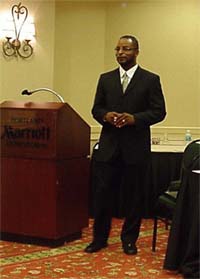
Mr. Harold Mitchell is the founder of ReGenesis, an active community-based organization with 1,400 members. Under the leadership of Harold Mitchell, ReGenesis has established a broad and dynamic public-private partnership to foster identification, inventory, assessment, cleanup and redevelopment of contaminated sites.
Mr. Mitchell has acquired a noteworthy track record of being a leader and a risk taker. He identifies the needs and concerns of his community and takes collective actions to address these needs and concerns. Mr. Mitchell first became involved with environmental issues in 1994, when his personal interest in an abandoned fertilizer facility (IMC) across the street from his home grew. This led Mr. Mitchell to start talking to people in the community and listening to their growing concerns. These discussions led Mr. Mitchell to visit the South Carolina Department of Health and Environmental Control (SC DHEC) where he reviewed files on the formerly active manufacturing plant. During the review of the files, Mr. Mitchell learned about environmental contamination issues in his community, which led him to visit the local coroner and discuss the potential reproductive and developmental effects from the listed chemicals in the SC DHEC files. Mr. Mitchell's interest gained further momentum when he learned of the adverse health problems associated with these chemicals. He initiated an informal community health assessment and the evidence he gathered showed patterns of upper respiratory health problems, cancer and infant mortality within his own family, within his neighborhood and in the broader community.
As a risk taker in this traditionally conservative, small community, Mr. Mitchell continued to press on. His environmental related questions to the immediate neighborhood and broader community eventually got the notice of the establishment and business community. Mr. Mitchell was reportedly met with such responses as "let bygones be bygones," and remarks such as "all you are doing is stirring up trouble." Another particular response was that if "you are not willing to go all the way through with what you stumbled upon, you better leave it alone." Mr. Mitchell had every intention of going "all the way through" with this endeavor, because he was bothered by what his community faced in terms of health and environmental risks in the past, in the present and possibly in the future. This preliminary investigation by Mr. Mitchell set the stage for the phenomenal work he and ReGenesis have accomplished since1994. Mr. Mitchell and ReGenesis have orchestrated numerous community meetings, and meetings with EPA and other agencies to ensure their concerns about both Superfund sites were addressed.
Mr. Mitchell has a dedication to researching, making suggestions and following up on opportunities for community participation in environmental and health decisions. Mr. Mitchell's persistence for meaningful involvement extends to all the agencies he has worked with. Through Mr. Mitchell's community involvement efforts in Spartanburg, EPA has produced better work products (fact sheets, work plans, sampling plans, etc.), and better environmental and public health protections. Mr. Mitchell has exhibited exemplary skills of ensuring community involvement during the two Superfund site processes, as well as an Environmental Justice Demonstration Project. The Environmental Justice Demonstration Project is an outgrowth of the revitalization efforts of ReGenesis. In 1999, ReGenesis began to extend its focus beyond the two Superfund sites to include redevelopment for the targeted Forest Park and Arkwright communities. This was accomplished by establishing partnerships with city, county, state and federal government agencies to address local environmental and health issues as well as revitalization. Although these partnerships focused initially on cleanup issues, current plans represent renewed hopes for revitalization. Proposed revitalization will include housing, technology centers, job training centers and a health clinic. Through the efforts of Mr. Mitchell, Re-Genesis and the public-private partnerships they have formed, the Spartanburg area has received several grants for revitalization and redevelopment. These include a $20,000 Environmental Justice Grant, a $100,000 EPA Superfund Redevelopment Initiative Grant and a $200,000 EPA Brownfields Pilot Grant. The State of South Carolina was also awarded a $1,350,000 Brownfields Cleanup Revolving Loan Fund Grant, which will benefit four counties (including Spartanburg) and four cities.
2001 Award Winner: Laurie Nehring
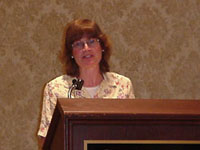
In 1997, members of People of Ayer Concerned About the Environment (PACE) faced a difficult situation. Not only had activities at Fort Devens left environmental damage, but its recent closure had also left a big hole in the local economy. In the early 1990s PACE had received a $50 thousand technical assistance grant from EPA to help support the group's effort to inform the community and provide input to the cleanup decision making process. The group had not spent most of the money and was in danger of losing it. Just at that time, Laurie was looking for a way to connect with her community and got involved with PACE. "Laurie was a breath of fresh air," says Jim Byrne, EPA's project manager for Fort Devens. "Laurie was able to step in and get the group together," says Jim Murphy EPA community involvement coordinator. "She put in the effort to utilize and maintain the EPA grant, which PACE used to hire a very competent consultant who was able to provide valuable technical insight."
Nehring and PACE began speaking out on cleanup decisions, bringing a whole new perspective to the table. As part of one major contribution, Nehring and PACE succeeded in changing the initial plan to consolidate six small Fort Devens' landfills into one large one near the downtown area of Ayer. By investigating the potential risks, informing the public, and mobilizing the local congressman, state senators, and other elected officials, Nehring and PACE convinced the cleanup officials to abandon that option. "Laurie helped PACE members position themselves as key players in the process, not just as critics," says Murphy. "They not only presented reasonable, well-supported concerns, but they also helped to devise realistic alternatives that would satisfy all parties involved."
When cleanup officials began looking for a new site for the landfill, Nehring and PACE sustained their involvement, meeting frequently to review the pros and cons of other siting options. The new landfill, which will feature state-of-the-art leak protection technology, is now under construction at a location that poses little risk to Ayer residents or the surrounding environment.
Looking back over her five years of work with PACE, Nehring can offer other concerned citizens valuable advice. "Remember that you are going to have ups and downs in your efforts. No matter how had it gets, don't forget that there are always other people out there facing similar issues, who believe in your cause."
2000 Award Winner: Tri-Valley Communities Against a Radioactive Environment (Tri-Valley CARES)

Tri-Valley CARES is a community group based in Livermore, California. It has been actively involved with the Department of Energy's Lawrence Livermore National Laboratory (LLNL) for over twenty years. Founded in 1983, the group comprises more than 2,600 active members from across the community, including artists, teachers, biologists, and engineers. According to its executive director, Marylia Kelly, the group has participated in researching environmental impacts and helping to oversee the cleanup of contaminated LLNL sites.
Due to its nuclear testing activities, one LLNL's site has been on EPA's Superfund National Priorities List (NPL) since 1987 and has been identified as one of the most contaminated sites in the country. "Tri-Valley CARES members put in a tremendous number of hours to educate themselves and the community on all aspects of the Superfund cleanup," says Kathy Seitan, EPA Region 9 Superfund project manager. "Their persistence and dedication have ensured that community needs are met."
In 1989, Tri-Valley CARES became the first community group in EPA Region 9 to win a Technical Assistance Grant (TAG), which provided financial resources to continue and expand its Superfund community involvement efforts. According to David Cooper, EPA Region 9 community involvement coordinator, Tri-Valley CARES used the TAG to keep the community informed about the technical and global issues of the cleanup. Members also acted as effective spokespeople by expressing community concerns and making specific technical comments to LLNL and EPA during all stages of the cleanup effort.
"Community involvement is very important to Superfund cleanups," Cooper says. "Not only does EPA have a regulatory responsibility to get the public involved, but the public has a right to know how their money is being spent, what the potential risks are, and how they can contribute to the decision-making process."
Tri-Valley CARES helped the public participate in decision-making by developing and circulating a set of 12 criteria for community acceptance of the site cleanup plan. The plan was initially developed by LLNL and serves as the legal basis for all future aspects of the cleanup. To achieve EPA approval, the plan must meet nine Agency criteria, including community acceptance. Tri-Valley CARES outlined acceptance criteria with community preference for the cleanup schedule, cleanup levels and methods, future land use, budget planning, and levels of public involvement.
"Part of our work as I see it is to take technical data and translate it into plain language to empower the community to become involved," Kelly says. "EPA and Livermore Labs each look at the cleanup through different lenses - they are interested in budget issues and following regulations. Our job is to press EPA to do the most they can, fulfilling our role in the mosaic of interested parties."
As part of its continuing community efforts, Tri-Valley CARES hosts monthly meetings open to the public to discuss the latest LLNL activities. The group also disseminates information via a Tri-Valley CARES monthly newsletter and provides Spanish translations of LLNL's environmental publications.

